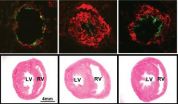(Press-News.org) Hamilton, ON (August 27, 2014) – Keeping a healthy heart may have as much to do with the quality of health care you have available as it does you avoiding risk factors such as smoking, bad diet and little exercise.
A large international study led by researchers at the Population Health Research Institute at McMaster University and Hamilton Health Sciences has found a that low-income countries which have people with the lowest risk factors for cardiovascular problems have the highest rates of cardiovascular events and death, while the high-income countries of people with the highest risk factors for heart conditions have a lower rate of severe heart problems and deaths.
The paper, published today in the prestigious New England Journal of Medicine, involved more than 156,000 people in 17 countries world-wide who took part in the Prospective Urban Rural Epidemiologic (PURE) Study.
"There is a real paradox. We have found that richer countries with higher risk factors have less heart disease and once people have a heart attack or stroke, the risk of dying is substantially less compared to poor countries," said Dr. Salim Yusuf, principal investigator for the study. But 80% of the deaths each year from cardiovascular disease happen in low and middle income countries.
Yusuf said the difference is the quality of health care. "We have found that health care is as important, if not more important, than avoiding the risk factors in reducing cardiovascular disease."
Yusuf added that for better heart health, "the rich countries should continue to deliver high quality health care while trying to reduce risk factors, while poor countries need to avoid the rise of risk factors but also substantially improve their health care."
Risk factors for cardiovascular problems include smoking, high cholesterol, high blood pressure, diabetes, obesity, stress and not enough fruits and vegetables or exercise.
Participants were from both urban and rural areas of four low-income countries of Bangladesh, India, Pakistan or Zimbabwe; 10 middle-income countries of Argentina, Brazil, Chile, China, Colombia, Iran, Malaysia, Poland, South Africa and Turkey; and from three high-income countries of Canada, Sweden and the United Arab Emirates.
INFORMATION:
Funding for the study came from the Population Health Research Institute, many national or local organizations in participating countries as well as the Canadian Institutes of Health Research, the Heart and Stroke Foundation of Ontario and unrestricted grants from several pharmaceutical companies.
For more information:
Veronica McGuire
Media Relations
Faculty of Health Sciences
McMaster University
vmcguir@mcmaster.ca
905-525-9140, ext. 22169
Better health care as important as controlling risk factors for heart health
2014-08-28
ELSE PRESS RELEASES FROM THIS DATE:
Researchers investigating new treatment for multiple sclerosis
2014-08-27
MINNEAPOLIS – A new treatment under investigation for multiple sclerosis (MS) is safe and tolerable in phase I clinical trials, according to a study published August 27, 2014, in Neurology® Neuroimmunology & Neuroinflammation, a new online-only, freely accessible, specialty medical journal. The publication is part of the Neurology® family of journals, published by the American Academy of Neurology.
The phase I studies were the first to test the drug candidate in humans. Studies with animals showed that the drug, which is called anti-LINGO-1, or BIIB033, may be able to ...
Bundled approach to reduce surgical site infections in colorectal surgery
2014-08-27
Bottom Line: A multidisciplinary program (called a "bundle") that spanned the phases of perioperative care helped reduce surgical site infections (SSIs) in patients undergoing colorectal surgery (CRS) at an academic medical center.
Author: Jeffrey E. Keenan, M.D., of the Duke University Medical Center, Durham, N.C., and colleagues.
Background: SSIs are associated with increased complications, length of hospital stay, readmission rates and health care costs. Efforts that have used systematic approaches, called bundles, that aim to incorporate best practices across the ...
Photodynamic therapy vs. cryotherapy for actinic keratoses
2014-08-27
Bottom Line: Photodynamic therapy (PDT, which uses topical agents and light to kill tissue) appears to better clear actinic keratoses (AKs, a common skin lesion caused by sun damage) at three months after treatment than cryotherapy (which uses liquid nitrogen to freeze lesions).
Author: Gayatri Patel, M.D., M.P.H., of the University of California Davis Medical Center, in Sacramento, and colleagues.
Background: AKs are rough, scaly lesions on the skin typically found on individuals with fair complexions who have had lots of sun exposure. The lesions have the potential ...
APOE, diagnostic accuracy of CSF biomarkers for Alzheimer disease
2014-08-27
Bottom Line: Cerebral spinal fluid (CSF) levels of β-amyloid 42(Aβ42) are associated with the diagnosis of Alzheimer disease (AD) and (Aβ) accumulation in the brain independent of apolipoprotein E (APOE) gene makeup.
Authors: Ronald Lautner, M.D., of Sahlgrenska University Hospital, Sweden, and colleagues.
Background: With the emergence of biomarker dementia diagnostics, interest in CSF biomarkers associated with AD, including Aβ42 and tau proteins, is increasing. The APOE gene is the most prominent susceptibility gene for late-onset AD. For the ...
NASA's TRMM Satellite sees powerful towering storms in Cristobal
2014-08-27
VIDEO:
NASA's TRMM Satellite Sees Powerful Towering Storms in Cristobal On Aug. 26, NASA's TRMM Satellite saw a band of thunderstorms with heights of over 15km (about 9.3 miles) and was...
Click here for more information.
NASA's TRMM satellite identified areas of heavy rainfall occurring in Hurricane Cristobal as it continued strengthening on approach to Bermuda.
NASA's Tropical Rainfall Measuring Mission or TRMM satellite flew above Hurricane Cristobal on August 26 at 11:35 ...
Experiments explain why some liquids are 'fragile' and others are 'strong'
2014-08-27
Only recently has it become possible to accurately "see" the structure of a liquid. Using X-rays and a high-tech apparatus that holds liquids without a container, Kenneth Kelton, PhD, the Arthur Holly Compton Professor in Arts & Sciences at Washington University in St. Louis, was able to compare the behavior of glass-forming liquids as they approach the glass transition.
The results, published in the August 6 issue of Nature Communications, are the strongest demonstration yet that bulk properties of glass-forming liquids, such as viscosity, are linked to microscopic ...
Novel 'butterfly' molecule could build new sensors, photoenergy conversion devices
2014-08-27
TALLAHASSEE, Fla. — Exciting new work by a Florida State University research team has led to a novel molecular system that can take your temperature, emit white light, and convert photon energy directly to mechanical motions.
And, the molecule looks like a butterfly.
Biwu Ma, associate professor in the Department of Chemical and Biomedical Engineering in the FAMU-FSU College of Engineering, created the molecule in a lab about a decade ago, but has continued to discover that his creation has many other unique capabilities.
For example, the molecular butterfly can flap ...
A touching story: The ancient conversation between plants, fungi and bacteria
2014-08-27
MADISON, Wis. — The mechanical force that a single fungal cell or bacterial colony exerts on a plant cell may seem vanishingly small, but it plays a heavy role in setting up some of the most fundamental symbiotic relationships in biology. In fact, it may not be too much of a stretch to say that plants may have never moved onto land without the ability to respond to the touch of beneficial fungi, according to a new study led by Jean-Michel Ané, a professor of agronomy at the University of Wisconsin-Madison.
"Many people have studied how roots progress through the soil, ...
Protein in 'good cholesterol' may be a key to treating pulmonary hypertension
2014-08-27
Oxidized lipids are known to play a key role in inflaming blood vessels and hardening arteries, which causes diseases like atherosclerosis. A new study at UCLA demonstrates that they may also contribute to pulmonary hypertension, a serious lung disease that narrows the small blood vessels in the lungs.
Using a rodent model, the researchers showed that a peptide mimicking part of the main protein in high-density lipoprotein (HDL), the so-called "good" cholesterol, may help reduce the production of oxidized lipids in pulmonary hypertension. They also found that reducing ...
Research geared to keep women from fleeing IT profession
2014-08-27
WACO, Texas (August 27, 2014) – For years, employers and experts have been trying to reverse the exodus of women from information technology positions.
They're failing.
Studies show that women are significantly underrepresented in the IT field, and the number of women who've graduated with degrees in computer and information science have plummeted from 37 percent in 1985 to 18 percent in 2011.
The failure to "stop the bleeding" stems, in part, from the industry's reliance on an oft-cited, outdated and under-studied research model, said Cindy Riemenschneider, Ph.D., ...



